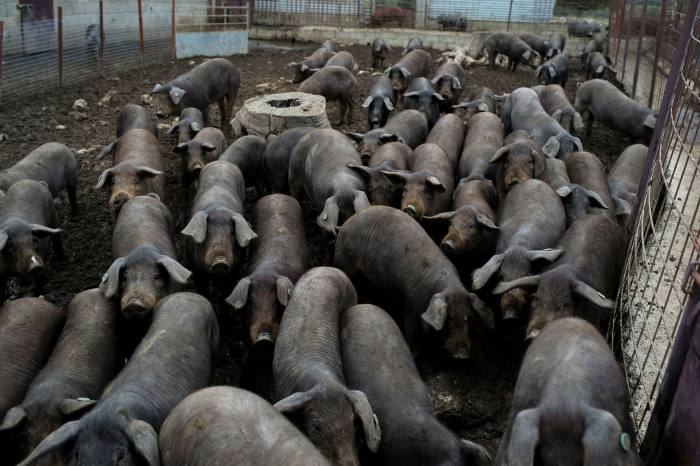Life on the farm was on a smaller scale when Alberto Pascual was young: just him, his father, a hired hand and about 50 pigs. Today, the 44-year-old Spanish agricultural engineer has five farms that have more than 40,000 pigs between them.
For Mr Pascual and others like him, the growth of pig farming in Spain — a country associated with porcine products such as chorizo and jamón ibérico — goes beyond the story of his own business’s expansion and success.
He has one answer to two big questions the country is wrestling with: how to reverse the depopulation of rural areas, and where to spend some of the €140bn in coronavirus crisis funds Spain expects to get from the EU over the next six years. That answer is pork.
“What we are doing is creating jobs, so that people have an opportunity to stay in the village — or come to the village — rather than go to Madrid,” said Mr Pascual, who employs some 50 people in the province of Avila in Castille-Leon.
He argued that investment in pig farming in depopulated areas such as his own is of such benefit — to employment, the environment and to the battle against the demographic decline of Spain’s heartlands — that EU funds should be ploughed into the sector. “All these priorities match the pork sector perfectly,” he said.
The problem of dwindling rural communities is a huge one for Spain. The vast majority of the population lives in just 10 per cent of the territory. By contrast, there are on average fewer than 13 people per square kilometre in about half the country’s land mass.
More than 75 per cent of Spanish municipalities are declining in population as inhabitants head to the cities for work and education, leaving the elderly behind. In Mr Pascual’s village of Muñogalindo, the number of inhabitants has dropped from 600 when he was a child to roughly 250 today.
Alberto Herranz, director-general of Interporc, an industry group for pork products, said the sector has an interdependent relationship with what people called “empty Spain”. He said that more than 40 per cent of pig farms were in rural municipalities with low population density and fewer than 5,000 inhabitants, often providing one of the few local sources of economic activity.
In all, he added, the pork industry provides some 21,000 people in such depopulated areas with work — a third of the jobs in the sector as a whole and an increase of about 11 per cent on the level of a decade ago. “If the growth is sustained, it will generate more jobs,” he added.
But the porkification of Spain’s rural economy is deeply contentious. The industry is now a massive one that often bears little resemblance to the traditional image of pata negra pigs traipsing through oak forests or of the high-end production of vintage 10-year-old hams. Almost 53m pigs were slaughtered in Spain in 2019 — a 43 per cent increase on the total 15 years before.
Exports to one market in particular are booming; in the nine months to September, Spanish farmers sold China more than 900,000 tonnes of pork — more than double the amount for the same period a year before — netting €2bn in the process.
Critics say that expanding the industry on such a scale is unsustainable — in terms of carbon emissions, waste and diet. “We can’t keep going on this path,” said Luís Ferreirim, who runs Greenpeace Spain’s agricultural campaigns.
According to Mr Ferreirim’s calculations, two-thirds of Spain’s cultivated land is used to grow animal feed. He added that the country’s livestock industry produces more than 80m tonnes of carbon emissions per year, with pig farms acting as the biggest contributor.
But in Avila, Mr Pascual said the bigger farms — often operated on an “integrated” basis in which the feed-producers own the pigs — offer chances for career development, for a less relentless rhythm of work, and greater economic opportunities.
He has established training facilities so that 16 and 17-year-olds can learn how to work on the farm in two-year courses that end with a job. He is also working on proposals — for the optimisation of manure as a fertiliser, the reduction of carbon emissions and the use of bio-gas, among others — that he hopes will qualify for EU aid.
Campaigners such as Greenpeace are not convinced — to say the least — that the pork industry will ride to the rescue of Spain’s underpopulated hinterland. Instead, they are calling for a moratorium on the sector’s growth.
“Spain is depopulating, even though the meat industry has been expanding for decades,” Mr Ferreirim said. “So it isn’t the answer.”
Yet Mr Pascual maintains that it is the pig industry that makes villages such as his own sustainable — because of the influx of jobs and economic activity.
“What is not sustainable is cities with no connection to the countryside. Livestock farming is the most sustainable thing there is,” he said. “Everyone has to eat.”
The Link LonkDecember 27, 2020 at 12:00PM
https://ift.tt/3hmjbkW
Spain’s pig farmers call for pork investment to save rural economy - Financial Times
https://ift.tt/2RsHZwT
Pork



No comments:
Post a Comment